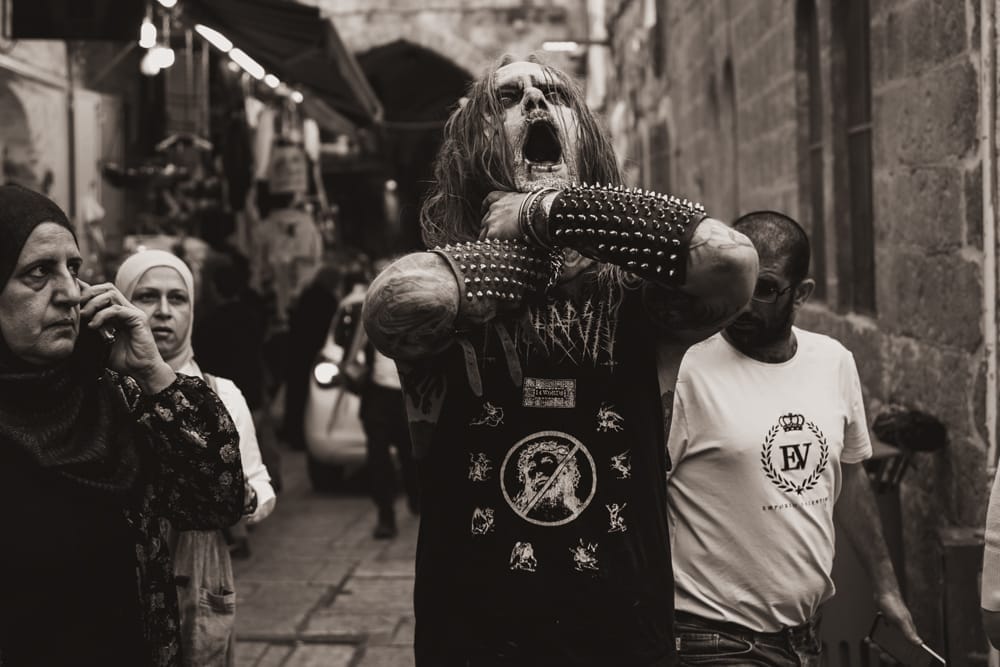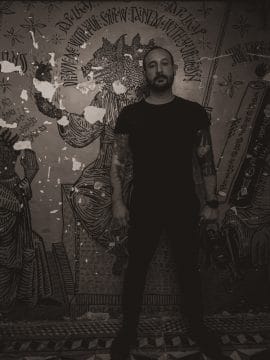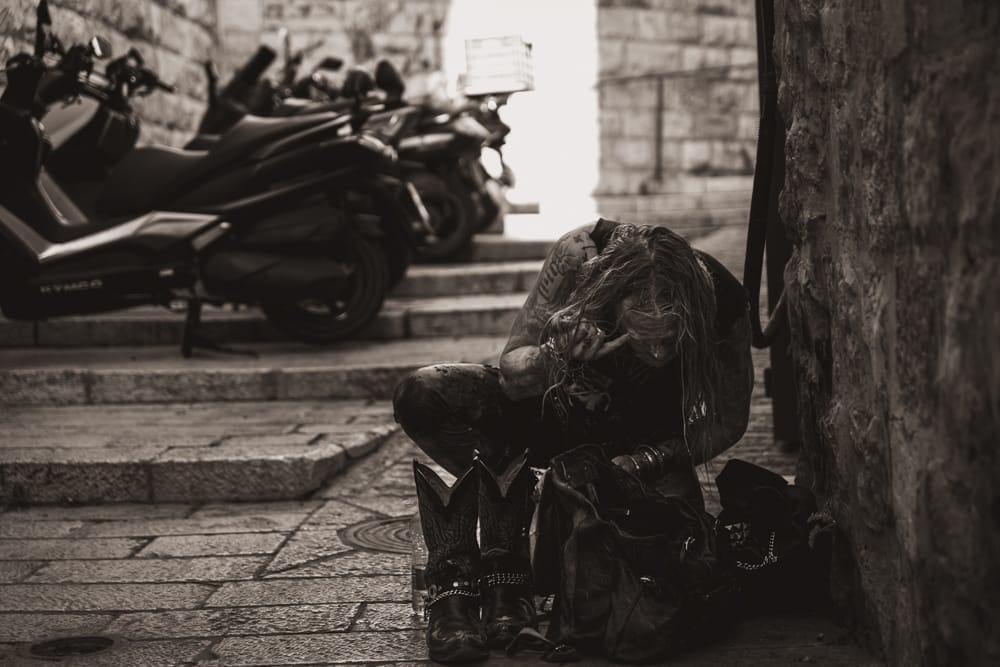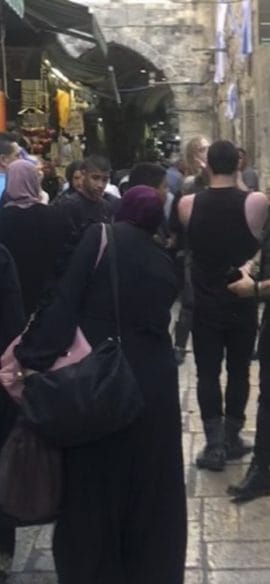There are photos that stand out from the mass of concert photos and promo images, photos that you can’t help but notice, photos that raise questions. „The Omen…“ is one such picture: it shows Wraath, the singer of the black metal band Darvaza – in the Via Dolorosa in Jerusalem, of all places. In an interview, photographer NECROSHORNS tells us about applying corpse paint in the side street, military patrols and the right lens.
Together with Björn alias Wraath (Darvaza), you took some very special photos along the Via Dolorosa in Jerusalem. Tell us, how did the idea for this shoot come to start?
It was a very curious situation because I had this idea about shooting a session in Via Dolorosa when I got booked for the festival in Israel. There was one band that was supposed to be part of the festival and I tested terrain with the comment of how interesting will be to shoot a session but they never replied. Then later Björn told me about shooting in Jerusalem in a place crowded with people and I said right away Via Dolorosa! So we started to plan how to do it.

What gave you the idea of photographing black metal musicians there?
The main idea was to do something blasphemous and provocative that was never done before and what better place to do it than the path that Jesus walked to the crucifixion?
Once the idea was born, how did you proceed? How do you prepare for a shoot like this?
Björn and I talked a bit about how to do it, how to find a place where to get ready and how we would proceed then but either of us had been there before so the idea was very raw and abstract as I didn’t know what to expect. At the festival we talked with Tal (one of the organizers) and we said what we thought about doing. He is from Israel and has been there several times so he knows better. He said, it could be possibly risky and then he asked „What place are you thinking to do it?“ and I said „Via Dolorosa“ and he said “Ugh that’s not gonna be easy”. So then we knew, we had to do it fast, find a way to get ready and use the seconds of “confusion” of the people to shoot the photos and get out of the place before people realized what we were doing.

Photographers can’t do without gear talk.: to what extent did this particular location influence your choice of equipment?
Finally this question! I have done many photo sessions so I know well which kind of equipment I need for each situation but the big difference is I have never done a session before where I had only one shot and not a second chance. We walked by the place before, we did a test photo, I knew already settings for the light and I decided to go for the Sigma Art 24/70 mm F2.8. Sometimes I shoot with the Sigma Art 50 mm F1.4 but this time I wanted the flexibility of zoom in or out.
How can we imagine the shooting process in concrete terms, especially with the eye-catching styling?
We found an empty side street where we decided that this was a good place to prepare. There was a lot of tension, militars patrol the street all the time because there are often religious conflicts and I was warned to avoid them as they can be very judgmental and we could ended up being arrested very easy. So we had to wait until they walked out of their station that was few meters away from the place we wanted to shoot.

In a public place, there are many uncertainties that are difficult to prepare for in advance. What situation did you end up in? Were there any problems or aspects that you hadn’t expected?
We shot in aprox 30 seconds: when we walked into the street, Björn walked infront of me covering himself. When he turned around a woman with two kids was next to him, one of the kids pointed at Björn and the woman took the kid and ran away from the place. There I realised everything could be ignited very easy so we acted fast and used the seconds of confusion and went put very fast of the place.
How did the other people in this place react to you?
To be honest aside from the woman with the kids that I already mentioned, I do not know. I was in a state of mind just focus on shooting. I saw shadows crossing and tried to capture them in the photo but that doesn’t mean I realised what was happening. When we stopped and walked away I noticed we were circled by a lot of people.

Black metal in such a religiously charged place can be perceived as quite provocative. Did you think about the risk you were taking beforehand?
Been provocative was the main reason of this session. We knew the risk and we gambled on our safety. I think what was at our side is that we had a plan. This is the kind of place that you never know what will happen. We were lucky in a way, just early the same day around that area people were screaming and insulting to us. Overall Jerusalem is fine but the more you approach to the religious places the more tension is around.
How would you describe your thoughts and feelings before, during and after the shoot?
Before was the uncertain feeling when you know you gonna do something that can go very bad, after was an adrenaline rush.
What kind of feedback did you receive after the pictures were published?
I will say most of the people well received and valued what we did. Many understand the message we wanted to capture with this photo and the risk behind it. But as everything there are also people doing critics of “there was no risk involved and everything was staged”. I find those kind of critics very funny because in so many years of existence of black metal … if there wouldn’t been any risk, why would no one have done it yet? Is easy to critice but first “they haven’t dared to do something similar” and second “they were not there”. So to everyone at their comfort of their homes I say that I invite them to do it. It is very easy to point out of the comfort of their homes but why not act then.

Are you satisfied with the result?
I’m very satisfied. This photo holds a big meaning to me but is not only the photo. It is also the story behind it. This is something I will remember forever.
Thank you for the conversation
Thank you for your interest and support.
Dieses Interview wurde per E-Mail geführt.
Zur besseren Lesbarkeit wurden Smilies ersetzt.

